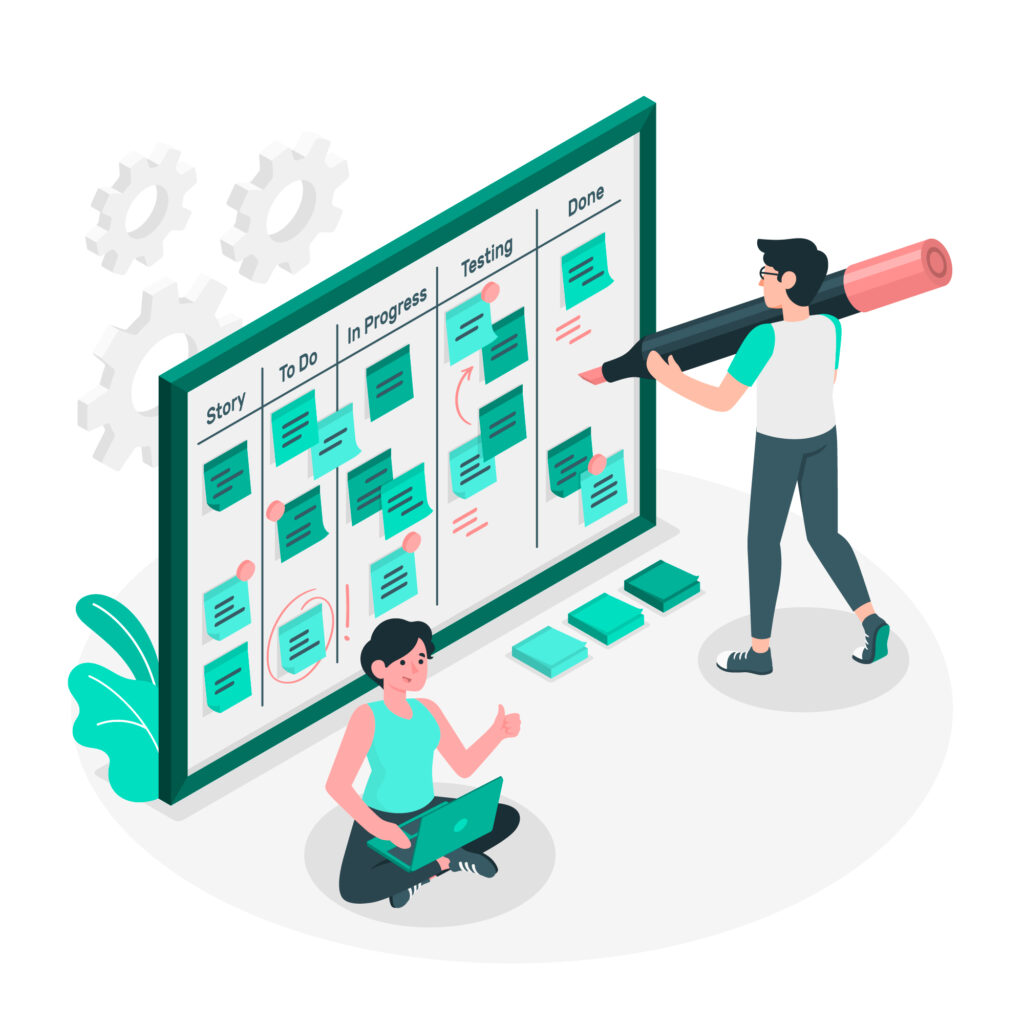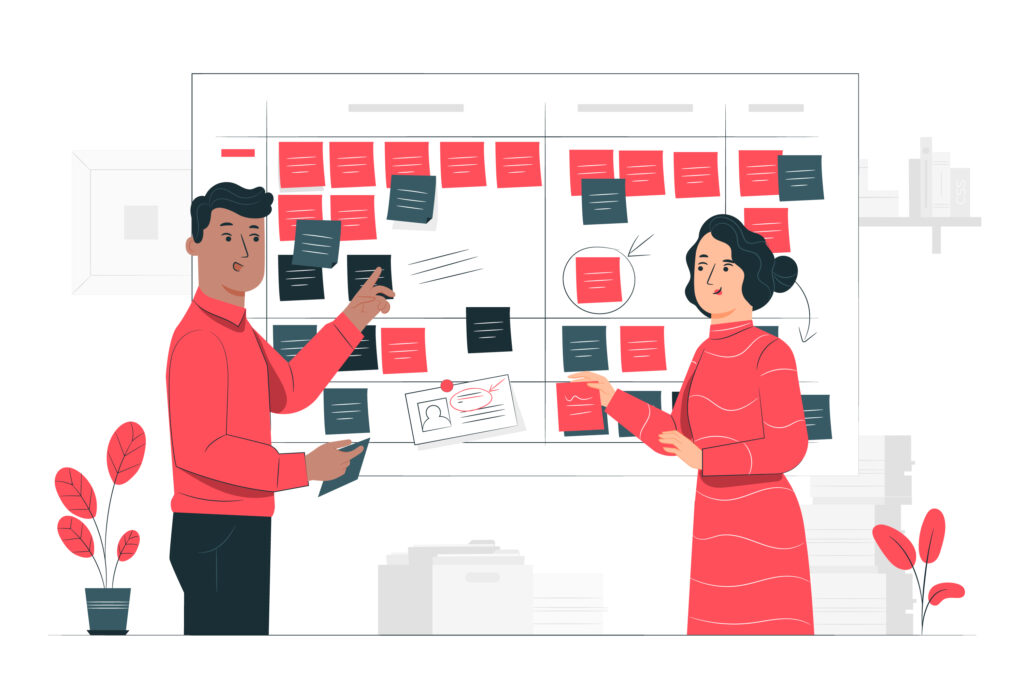Backlog Grooming vs Sprint Planning: What is the Scrum Framework?
Learning more about backlog grooming vs sprint planning is crucial. Let us begin from the basics. Scrum is a simple approach. It contrasts sharply with a complex web of interconnected elements. It isn’t a rigid process. Instead, Scrum applies empirical principles akin to scientific methods. It serves as a flexible method to navigate uncertainty and tackle complex issues, favoring human interaction and self-management over rigid algorithms.

Backlog Grooming vs Sprint Planning: What is Backlog Grooming or Refining?
Backlog grooming, also known as refining, involves reviewing the product backlog and optimizing it by removing, adding, prioritizing, or elaborating on user stories.
The grooming aims to improve the task list, ensuring tasks align’s with the company’s strategic goals. The product backlog encompasses all tasks the product team plans to address eventually, spanning from new features to bug fixes. We may plan some tasks for the next sprint, while can leave others for a while.
A backlog serves as a comprehensive inventory of tasks supporting broader strategic plans. In Agile methodology, there are three primary types of backlogs:
- Product backlog: Encompasses features awaiting prioritization for implementation.
- Release backlog: Consists of features earmarked for a specific release.
- Sprint backlog: Contains user stories slated for completion within a defined timeframe.
A well-maintained backlog acts as a definitive reference point for the team’s planning endeavors. It enables easy identification of upcoming tasks and their prioritization, facilitating assignment of work and fostering discussions on task requirements.
What Occurs During Backlog Grooming?
Backlog grooming sessions play a crucial role in ensuring project efficiency. These sessions bring the team together to prepare user stories in the product backlog for sprint planning.

Regularly scheduling backlog grooming sessions ensures that we properly prioritize the right stories. It will keep the product backlog dynamic instead of letting it become a graveyard for ideas.
During backlog grooming, we pursue three primary objectives:
- Breaking down large user stories into smaller, more manageable tasks.
- Conducting group discussions on user stories and addressing any questions to ensure alignment among team members.
- Reviewing upcoming user stories against the team’s “definition of ready,” adding essential contextual information and acceptance criteria.
By the end of a backlog grooming session, the team should have a prioritized list of user stories ready for the upcoming sprint.
For agile product development teams, this process, also known as backlog refinement or story time, is a routine practice aimed at preparing backlog user stories for multiple sprints ahead. Regular grooming sessions ensure that relevant stories are prioritized and prevent the product backlog from becoming stagnant.
These sessions also serve various tactical purposes:
- Breaking down large user stories into smaller tasks.
- Facilitating team discussions to clarify uncertainties and address queries related to user stories.
- Adding necessary contextual details and acceptance criteria to incoming user stories to ensure they meet the team’s “definition of ready.”
While not always the case, during these sessions, the scrum master, project manager, and delivery team may occasionally use them to estimate stories and allocate story points.
What is the purpose of Backlog Grooming?
Following a backlog refinement meeting, a prioritized list of user stories should be established, with the most critical information contained in the top items. Stories near the top that are too large should be broken down into smaller, more manageable tasks.

As you move down the list, stories may increase in size and deviate from your team’s “definition of ready.” Completing tasks during these sessions fosters shared knowledge and enhances the efficiency of sprint planning meetings over time.
Who runs Backlog refinement sessions?
The product owner or product manager typically leads backlog refinement sessions. It doesn’t mean they’re solely responsible for organizing them. These sessions are often led by the Scrum Master (in Agile Scrum teams), a project manager, or another team member. The individual in charge is responsible for:
- Organizing the meeting and ensuring the right participants are invited and present.
- Facilitating a productive and focused discussion.
- Acting as a timekeeper to keep the discussion on track if the team encounters obstacles.
- Sending follow-up communications as necessary.
Who is involved?
Backlog grooming sessions are designed to be collaborative, involving the entire cross-functional team. To effectively develop user stories, the combined expertise of various team members is necessary. The key roles typically involved are:
- Someone to initiate discussions: This could be a product owner, product manager, scrum master, project manager, or even an agile coach or consultant.
- The product owner and/or other members of the product team.
- Representatives from the delivery team (if the team is too large, management representatives can attend).
- Representatives from Quality Assurance.
What should be done in Backlog Grooming?
Before joining a backlog grooming session, it’s essential for everyone to plan and prepare adequately. This is particularly crucial for product owners and managers, as unpreparedness on their part can result in frustratingly unproductive meetings.
Key steps to be taken include:
- Reviewing Strategic Goals: It’s important to revisit the strategic objectives of the project or product. This is to ensure alignment with the backlog items being discussed.
- Consulting Stakeholders: Engaging with stakeholders helps in understanding their needs and priorities. This can inform the backlog prioritization process.
- Reviewing Key Metrics: Analyzing relevant metrics provides valuable insights into the performance and impact of previous backlog items, aiding in informed decision-making for future prioritization.
Once these preparatory steps are completed, participants should be able to address the following questions during the grooming session:
- What are the current prominent themes and stories in the backlog?
- Why are these items prioritized at the top of the list presently?
- What value do they bring, and how do they contribute to achieving our strategic objectives?
By addressing these questions, we can proceed more effectively with the backlog grooming session, ensuring that backlog items align with strategic goals and that all parties have clear priorities.
What is sprint planning?
Sprint planning, distinct from backlog grooming, is a more focused activity centered on preparing for the upcoming sprint. With sprints typically lasting around two weeks, sprint planning revolves around determining which user stories the team aims to complete in the immediate future.
Each sprint has its own dedicated backlog. Picture the product backlog as encompassing all the tasks the team aims to accomplish, while the sprint backlog represents a curated list of items to be tackled in the current sprint.

The sprint backlog includes user stories taken from the product backlog, alongside any stories that the team didn’t finish in the previous sprint. Teams convene sprint planning meetings before each sprint, typically dedicating a maximum of two hours per week of the sprint to planning. However, experienced or highly efficient teams may require less time.
Sprint planning serves as a crucial agile event, kickstarting the sprint by delineating achievable goals and outlining how the team will collaborate to deliver any defined outcomes.
What happens during Sprint planning?
This is one of the crucial factors in backlog grooming vs sprint planning. Sprint planning meetings, as the name suggests, are gatherings where teams map out the upcoming sprint, setting the timebox duration, define the sprint goal, and determining where to commence. By articulating the sprint’s agenda and focus upfront, teams can bolster their sense of empowerment and motivation, laying the groundwork for success throughout the sprint.
There are five fundamental components to a sprint planning meeting:
- The What: The product owner outlines the sprint goal and specifies which backlog items contribute to that goal. The team then deliberates on what can feasibly be accomplished during the sprint and strategizes the necessary actions to achieve these objectives.
- The How: The development team devises the work plan essential for achieving the sprint goal, considering the tasks, dependencies, and potential obstacles.
- The Who: The entire development team and the product owner are essential participants in the sprint planning meeting, ensuring alignment and shared understanding of the sprint objectives.
- The team identifies the backlog items from the product backlog that it will incorporate into the sprint, selecting those most relevant to the sprint goal and feasible for completion within the sprint timeframe.
- The Outputs: Following the planning meeting, the team emerges with a clear understanding of the sprint goal and a defined roadmap for commencing work towards that goal. This clarity fosters alignment and sets the team on a path for productive collaboration throughout the sprint.
Why is Sprint Planning Important?
Sprint planning serves as the foundation for the upcoming sprint, fostering transparency and alignment within the team. It ensures that everyone is clear on the sprint goals and understands their respective roles in achieving them.
By breaking down the project into manageable segments, sprint planning enables teams to spend less time deliberating on tasks and more time making tangible progress towards their objectives. This iterative approach not only enhances efficiency but also boosts morale, as the frequent completion of smaller tasks provides a sense of accomplishment and motivation.

Sprint planning initiates the sprint by outlining the tasks that the Scrum Team will undertake collectively. The collaborative effort of the team results in a master plan for the sprint.
During sprint planning, the Product Owner ensures discussing and linking essential Product Backlog items to the Product Goal. Additionally, the Scrum Team may invite other stakeholders to provide valuable input.
During sprint planning, we typically address the following topics:
- Why is this Sprint significant?
- What can we accomplish during this sprint?
- How to execute the work?
A successful sprint planning session yields two critical outcomes:
- The sprint goal: A concise overview of the team’s objectives for the upcoming sprint.
- The sprint backlog: A curated list of stories and other items from the product backlog that the team has selected to prioritize during the sprint.
What Should Sprint Planning Include?
Sprint planning aims to gather crucial details about the team’s work set up for the upcoming sprint. To ensure comprehensive coverage, the sprint team should aim to address the following topics during this meeting:
- Determine the team’s overall strategic goal for the upcoming sprint.
- Review the product backlog and decide which items to include in the next sprint backlog, providing rationale.
- Facilitate agreement among the team members on the proposed sprint goal and backlog items (led by the scrum master).
- Discuss the team’s capacity for the sprint, considering factors such as availability and skill sets.
- Identify any potential issues or impediments that could hinder or delay project development.
- Assign tasks to the new sprint backlog based on skill capabilities, capacity, and other relevant factors.
- Estimate the time required for each task and establish the criteria for defining “done” for each item.
- Confirm the start and end dates for the sprint.
- At the outset of the meeting, provide sprint-related questions to ensure focus and alignment.
By covering these items, sprint planning meetings can effectively set the stage for a productive and successful sprint, ensuring clarity, alignment, and effective allocation of resources.
Who Typically Organizes Sprint Planning?

While input from various members of the organization can be valuable, certain individuals play crucial roles in organizing and leading sprint planning sessions:
- The Scrum Master: The Scrum Master takes charge of the sprint planning meeting, facilitating and coordinating the session to ensure its effectiveness and adherence to Scrum principles.
- The Product Owner: The Product Owner plays a central role in sprint planning by providing insights into the product backlog items, clarifying any questions related to the backlog, and assisting in defining the sprint goal.
Their primary responsibility is to represent the interests of stakeholders and ensure that the team delivers value with each sprint.
- The Product Manager: The Product Manager, who may also serve as the Product Owner but not necessarily, contributes to sprint planning by providing strategic direction and input based on their understanding of market needs and product strategy.
- The Development Team: The development team members are primarily responsible for executing the work agreed upon during sprint planning. They commit to completing the tasks, estimate deadlines, and communicate any capacity or skill-set issues that may impact their ability to deliver the work effectively.
These key participants collaborate during sprint planning to establish a shared understanding of the sprint goals, select backlog items for inclusion in the sprint, and outline the plan for achieving those goals within the sprint timeframe.
Backlog grooming vs. sprint planning
You’ve grasped the definitions of backlog grooming and sprint planning and likely discerned some of their similarities and distinctions.
Sprint planning sessions concentrate on imminent tasks, specifically those slated for the upcoming sprint. Conversely, backlog grooming sessions take a broader perspective, considering the entirety of the project to aid in task prioritization.
To bolster your confidence in forthcoming planning sessions, let’s delve deeper into their similarities and differences.
The similarities:
Backlog grooming and sprint planning are integral parts of the product development cycle within the Scrum framework, serving as processes to organize a team’s work.
Both sessions aim to involve all relevant stakeholders and benefit from the guidance of a skilled facilitator, ensuring alignment and shared understanding among team members. The presence of someone who can represent the “voice of the customer” is beneficial for both backlog grooming and sprint planning sessions.
Both backlog grooming and sprint planning contribute to the Scrum process by assisting teams in prioritizing work and laying the groundwork for future projects.
The differences:
Sprint planning occurs once before the start of each sprint. Backlog grooming is an ongoing process without a fixed schedule. The sessions have a narrower focus, addressing short-term goals for the upcoming sprint, whereas backlog grooming encompasses all work of interest to the team, including both short- and long-term goals.
Sprint planning meetings involve all team members participating in the next sprint. backlog grooming may involve a smaller subset of team members.
Although backlog grooming and sprint planning share similarities, they have distinct purposes. Backlog grooming focuses on the entire project to aid in prioritization, while sprint planning zeroes in on near-future tasks.
Prioritize backlog grooming before sprint planning to ensure that we plan sprints around the most critical items in the backlog. Sprint planning meetings require the presence of the entire team, including product owners, while backlog grooming sessions may involve only a few team members.
[Want to learn more about backlog grooming vs sprint planning? Click here to reach us.]
Conclusion
With the support of our Bobcares support team, we have now seen the comparison between backlog grooming and sprint planning. This reveals their complementary roles in the Scrum framework and product development cycle. While both processes serve to organize a team’s work and ensure alignment with strategic objectives, they operate with distinct focuses and timelines.
Backlog grooming offers a comprehensive view of the project. This facilitates task prioritization and ensuring that the backlog remains dynamic and relevant. It involves continuous refinement of backlog items to align with evolving priorities and strategic goals.
On the other hand, sprint planning hones in on the immediate future. This delineates achievable goals and outlines the tasks to finish within the upcoming sprint. It sets the stage for focused collaboration and efficient execution, fostering transparency and alignment within the team.
Despite their differences, both backlog grooming and sprint planning contribute to the success of Agile projects by fostering collaboration. This allows better decision-making, and maximizing the value delivered with each sprint.
By understanding the nuances of backlog grooming and sprint planning and leveraging them effectively within the Scrum framework, teams can enhance their productivity. They can improve the responsiveness, and ability to deliver value to stakeholders consistently.







0 Comments